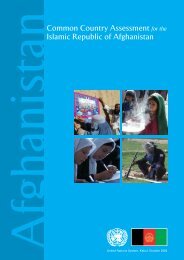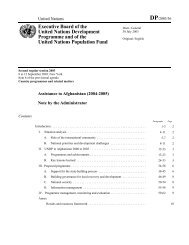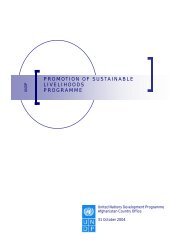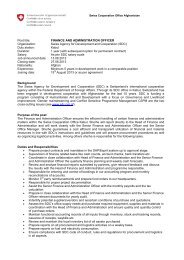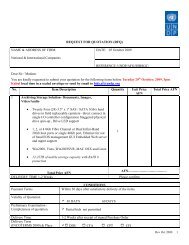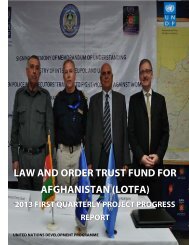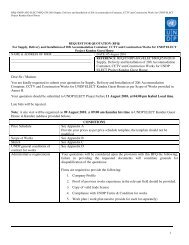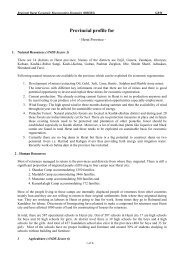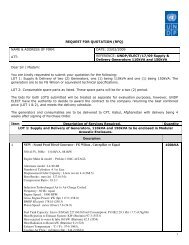(DIAG) Annual Project Report 2010 - UNDP Afghanistan
(DIAG) Annual Project Report 2010 - UNDP Afghanistan
(DIAG) Annual Project Report 2010 - UNDP Afghanistan
You also want an ePaper? Increase the reach of your titles
YUMPU automatically turns print PDFs into web optimized ePapers that Google loves.
Disbandment of Illegal Armed Groups (<strong>DIAG</strong>)<br />
<strong>Project</strong> ID 00043604<br />
16<br />
of multiple proposals for the provision of educational and development inputs. A district<br />
analysis of Shindand, done by the ANBP regional office, provided valuable background<br />
support for these activities.<br />
Fifty two Hezbi-Islami ex-combatants who had reconciled with the GoA were being<br />
supported in Puli Khumri district of Baghlan by <strong>UNDP</strong>/<strong>DIAG</strong>. They had been initially<br />
provided with a package of food and non-food items till 20 th June <strong>2010</strong>. Two missions were<br />
conducted in September to determine the current status of the reconcilees, assess the<br />
situation, and formulate potential support requirements.<br />
Fifty two people from among the reconcilees joined the HALO Trust, and were transferred<br />
to Kabul for training. The training started on 6 th November in a HALO camp located in Karizi<br />
Mir, north of Kabul. The trainees finished their training course on 8 th December and were<br />
subsequently employed by the HALO Trust.<br />
B. Strategic communications and public awareness<br />
During the year, <strong>DIAG</strong> also organized and facilitated a number of successful public<br />
information initiatives in support of D&RC initiatives throughout the country, organizing<br />
round-table television debates, public service announcements and radio programmes on<br />
peace and reintegration and <strong>DIAG</strong>. Special activities were organised on Peace Day, 21 st<br />
September, on disarmament efforts in <strong>Afghanistan</strong>; these included a one hour live-TV talk<br />
show with representatives from the D&RC and a radio show with a member of parliament.<br />
An awareness campaign about peace initiatives was organised especially for Hajjis, who<br />
were given informational packages which included a peace and reintegration related<br />
brochure and leaflet, as well as a small sized Holy Quran. <strong>DIAG</strong> also supported the GoA in its<br />
information campaign directed at civil society organizations and women’s rights groups<br />
with a role to play in peace and reintegration efforts.<br />
The cumulative result of these information activities is that <strong>DIAG</strong> has become a well-known<br />
name in <strong>Afghanistan</strong>, and the achievements in establishing a large number of peace<br />
districts and the benefits of disarmament have been well publicised. These information<br />
activities have helped bring about awareness of the goals, process, and benefits of <strong>DIAG</strong><br />
and broader peace-building efforts.<br />
III. Implementation Arrangements<br />
The activities of the <strong>UNDP</strong>/<strong>DIAG</strong> project were carried out under the Direct Implementation<br />
Modality (DIM) through <strong>UNDP</strong> <strong>Afghanistan</strong>. The project’s activities were implemented<br />
under the overall leadership of the Vice Chairman of the Disarmament and Reintegration<br />
Commission (D&RC), who was responsible for defining policies, priorities and guidelines of<br />
the <strong>DIAG</strong> project. The government therefore lead the activities with support from<br />
<strong>UNDP</strong>/<strong>DIAG</strong>. The JS of the D&RC, whose members included representatives of the MoI,<br />
Ministry of Defence (MoD), National Directorate of Security (NDS) and the MRRD, were the<br />
executive body of the D&RC explicitly involved in coordinating and implementing <strong>DIAG</strong>.<br />
The project provided technical and logistical support for the implementation of weapons<br />
management issues. At the regional level, seven regional offices supported Provincial<br />
Security Committees in each province for <strong>DIAG</strong> activities. The Provincial Security<br />
<strong>Annual</strong> Progress <strong>Report</strong> | <strong>2010</strong>



